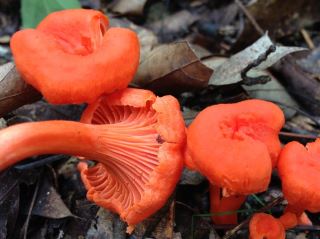Welcome to Mushroom World
Step into the fascinating world of mushrooms with Mushroom World - your go-to resource for fungi information. Our site is a comprehensive resource offering information and stunning images of mushrooms. If you're curious about what fungi actually are and how they differ from plants and animals, be sure to visit our what are fungi? page for an easy-to-understand explanation.
Since there are thousands of known species of mushrooms, we have tried to limit those we list to the most common ones. New species are also continuously added to the site.
So come on in and explore the wonders of mushrooms with us. We hope you find our site informative, inspiring, and a valuable resource on your journey of mushroom discovery.
Below is an overview of the main features and functionalities of our site.
Browse the database
You can browse the database from the alphabetical list or search the database based on mushroom names or properties.
Help identify a mushroom
If you know the characteristics of a mushroom but need help identifying it, try using our mushroom identification helper. It is a tool designed to assist you in identifying mushrooms that you may come across. If you're new to mushroom identification, be sure to check out our mushroom identification basics guide for an easy introduction to key features and terminology.
Identification Quiz
We have also created a quiz where you can test your fungi identification knowledge. You can repeat the quiz as many times as you want, each time with new questions.
Upload mushroom pictures
If you have pictures of mushrooms you would like to have included on our site, please use the upload form to upload these files and we will see if we can include them.
Today's Mushroom
Today's mushroom is Cantharellus cinnabarinus (Red Chanterelle). It grows in North America.
Dimensions: Cap 1-4 cm across, stem 1-4 cm tall * 0.5-1 cm thick
Description: Cantharellus cinnabarinus, commonly known as the Red Chanterelle or Cinnabar Chanterelle, is a species of fungus belonging to the Cantharellaceae family. This vibrant mushroom is characterized by its striking red-orange to cinnabar colouration and distinctive funnel-shaped cap. Unlike its more widely known cousin, Cantharellus cibarius, Cantharellus cinnabarinus is smaller in size. Cantharellus cinnabarinus forms mycorrhizal relationships with hardwood trees, notably beech and oaks. It grows either alone, scattered, or in groups.
Cap starts convex, broadening as it ages, eventually becoming flat or shallowly depressed at the centre. Initially, the margin curls inward, later expanding and developing waviness. Colour ranges from flamingo pink to cinnabar red, with hues of pinkish-orange or reddish-orange. The mushroom has gill-like veins under the cap that run down the stem, not gills. Flesh whitish or tinged with the cap color; not changing color when sliced. Stem solid, equal when young but by maturity usually tapers downward from the cap. It is coloured like the cap or paler. Spore print whitish or slightly pinkish.
Microscopic Features: Spores measure 6-8 x 3.5-5 µ and are ellipsoid, sometimes showing constriction. They have a smooth surface, are inamyloid, and appear ochraceous in KOH. Their contents are finely granular.
Cantharellus cinnabarinus on the MushroomExpert.Com Web site.
The first photo is by dario.z and licensed under the Creative Commons Attribution-ShareAlike 3.0 Unported license.
This site contains no information about the edibility or toxicity of the mushroom.


If you are interested in this mushroom, look it up in our database. You can find more detailed pictures there.
Many mushrooms are poisonous, and some can be lethally toxic. Distinguishing between edible and poisonous mushrooms can be very challenging. Therefore, we strongly advise against consuming wild mushrooms. This website does not contain any information about the edibility or toxicity of mushrooms.
Although efforts have been made to ensure accuracy on this website, the information may contain errors and omissions. Therefore, all content provided is for educational and informational purposes only and should not be relied upon or used as a basis for consuming any plants or mushrooms.
External links are provided for reference only. We do not endorse or take responsibility for the content, advice, or products found on these sites or in any advertisements shown on this website.